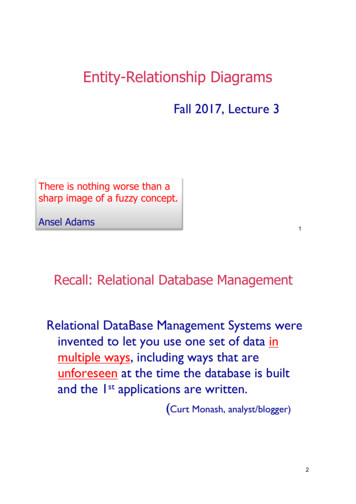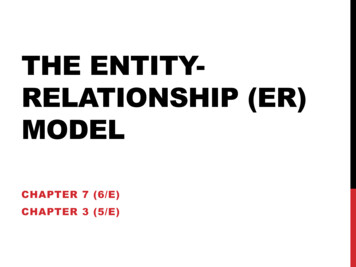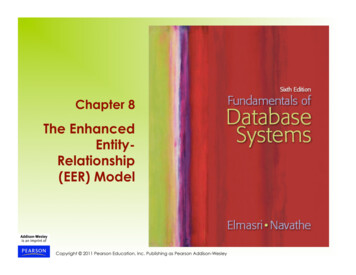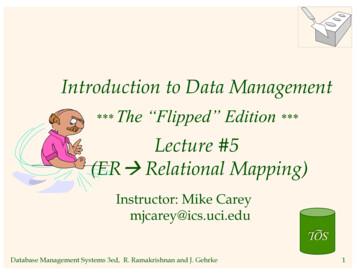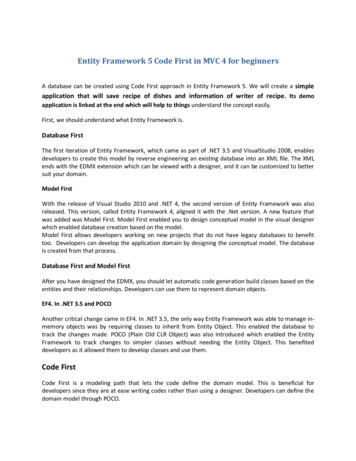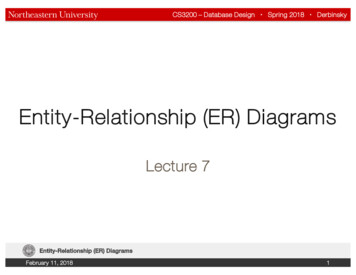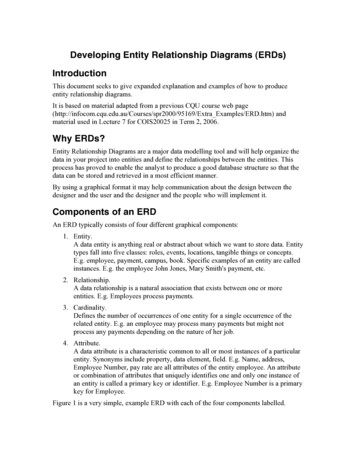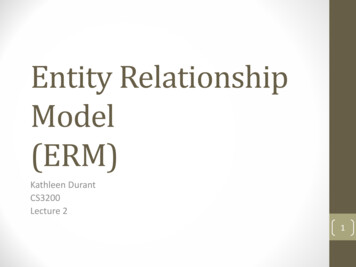
Transcription
Entity RelationshipModel(ERM)Kathleen DurantCS3200Lecture 21
What is the goal of Modeling?Derive a logical description of our data.Understand the various ways in which the data is used.Identify the important or central data.Make decisions about the relationships between data andhow to decompose a design. Organize the data to facilitate its uses. Be reasonably efficient. Allow for efficiency of implementation. 2
Why use a model? The data is probably reasonably complex. There are several different sorts of accesses. The data and design will evolve over time: You want a history of this evolution. You want to be able to make changes without constantly dumpingand loading your data. Good mental structuring will lead to good physical structure. The act of organizing will make people think of things that gotdropped on the floor.3
How do you develop a model ?Steps to model development Identify the entities. Determine all significant interactions. Analyze the nature of the interactions.4
Entity relationship model(ERM) Maps nicely into a relational data model.Provides a set of terminology and a graphical display of the data.Fairly simple to understand.Alternatives Process and data flow analysis. Seat of the pants methodology. That’s sloppy thought Leads to a sloppy database with excessive redundancy, poor performance,and inability to get the job done.5
The ER Model: Entity Entities: All the world is a set of things. Represented by a rectangle. They have their attributes and relationships. An entity is one object, it is described via its attributes. Entity Set: A collection of similar entities, e.g., allmovies. Typically, All entities in an entity set have the same set of attributes. (Exception: ISA hierarchies violate this condition.) Each entity set has a key.6
The ER Model: Attributes Attributes: Describe the entities. There are many different types of attributes Represented by an oval. Attached to entities with a line. Each attribute has a domain. A set of potential values. Analogies: Fields in a record Elements of a data structure or class object7
Types of Attribute Simple: indivisible (like a native type). Examples?Composite: decomposable or structured. Examples?Single-valued: only one per entity. Examples?Multi-valued: zero or more per entity. Examples? Represented by a double oval Domain of an attribute: it’s possible values Key: subset of attributes that uniquely identifies an entity(candidate key)8
Example: from ePhoto9
Attribute details Null attributes Do not know the value (NA). Attribute does not exist (e.g., children). Derived values An attribute that can be computed from other attribute(s) Represented by a dashed oval.10
Example: from NamePhoto11
Relationships A relationship is a mapping or an association between two ormore entities. Relationship represented as a line connecting two entities orentity sets. A Relationship set: a collection of similar relationships,mapping between 2 entity sets. Represented by diamondsKey design issue: distinguishing between entities andrelationships -- seems obvious but isn’t always.12
Degree of a Relationship Degree of relationship identifies the number of entities thatparticipate in the relationship. Binary relationships are most common. Higher degree relationships can be modeled as a set of binaryrelationships.13
Example: RelationshipsBirthdateAgeIs elationships can have attributes too14
Relation Constraints: Cardinality The logical structure of the data may impose constraints – ERM allowsyou to represent these constraints Cardinality: defines the relationship between the entities in terms of #’s 1 to 1: represented as 2 arrows pointing into the relationshipMovieActor 1 to many: one arrow emanating from the entity set with thecardinality of many (or pointing to the 1 cardinality)MovieActor Many to manyMovieActor15
Describe the wacky Movie worldMovieActorEach actor can be in 1 movie and each movie has 1 actor.MovieActorEach actor can only be in 1 movie but a movie can have 0, 1, or n actors.MovieActorA movie can have 0, 1, or n actors and an actor can appear in 0, 1, or n movies.16
Constraints: Existence Entity X is existent dependent on Entity Y if X can only exist if Yexists. Has implications for deletion: Deleting Y must force delete of X as well. In this example: X is the subordinate entity Y is the dominant entity17
Constraints: Participation If every entity in an entity set E must be part of a relationshipR, then E participates totally (as opposed to partially). Total participation often indicates existence dependencies. Total participation represented by a double line.18
Existence: Example Assume actors only exist in the IMDB database if they havebeen in at least one movie If you delete a movie from IMDB Must also delete actors that only appeared in that one movie19
Types of Keys Superkey: an attribute or set of attributes that uniquelyidentifies an entity--there can be many of these Candidate key: a superkey such that no proper subset of itsattributes is also a superkey (minimal superkey – has nounnecessary attributes) Primary key: the candidate key chosen to be used foridentifying entities and accessing records. Unless otherwisenoted "key" means "primary key“ Represented with an underline Used for physical clustering of data Alternate key: a candidate key not used for primary key Secondary key: attribute or set of attributes commonly usedfor accessing records, but not necessarily unique Composite key: a key requiring more than one attribute20
Example: KeysActor seDatePhoto21
Weak vs. Strong entity sets An entity set without a primary key is called a weak entity set Represented by a double rectangle Corresponding relationship represented with a double diamond A discriminator (partial key) distinguishes among elements ofa weak entity set. An entity set with a primary key is called a strong entity set Members of the strong entity set are dominant; members ofthe weak entity set are subordinate22
Example: Weak entity setActor IDSceneBirthdateAgeNumberIs 3
Extended features Specialization Designating subgroups within an entity set (think subclasses or sub-typing). A single entity set can have multiple specializations. Represented using a triangular ISA designator. Generalization Inverse of specialization. Aggregates similar entity sets Represented using a triangular ISA designator. Generalized entity set or the basis of a specialization is called ahigher level entity set. (The others are lower level entity sets.) Familiar if you have used objects:Superclass/subclass.Inheritance.If the entire schema has only single inheritance, then the design is a hierarchy.If the schema has multiple inheritance, it is a lattice.24
AActionDramaLowerEntitySetComedyISA function defines a Hierarchy25
Generalization constraints Membership Condition-defined: membership in the generalization or(specialization) is based on a predicate. User-defined: membership is defined manually. Cardinality Disjoint: each entity belongs to a single lower level entity set. Single genre for a movie Overlapping: entities may belong to multiple lower level entity sets. Movie classified using multiple genres Completeness Total: every higher level entity must belong to a lower level entityset. All movies have at least one genre. Partial: higher level entities may or may not belong to lower levelentity sets. Some movies do not fall into any movie genre.26
Aggregation When relationship sets have their ownrelationships Provides a method to build up complicatedentities Allows us to treat a relationship set as anentity set Represented as a box around therelationship27
Example: AggregationSceneActor IDBirthdateAgeNumber Is inMovieActorRoleDirectorTitleReleaseDateOther examples?NamePhoto28
Summary of Conceptual design Conceptual design follows requirementsanalysis Yields a high-level description of data to be stored ER model popular for conceptual design Constructs are expressive, close to the way people think abouttheir applications Basic constructs: entities, relationships, and attributes (ofentities and relationships) Some additional constructs: weak entities, ISA hierarchies, andaggregation Note: There are many variations on ER model29
Summary of ER ER design is subjective. There are often manyways to model a given scenario. Analyzingalternatives can be tricky, especially for a largeenterprise. Common choices include: Entity vs. attribute Key for the entity / to store or discard an attribute Entity vs. relationshipBinary or n-ary relationshipUse of ISA hierarchiesUse of aggregation30
Concepts: Part 1 Entity: a thing (abstract or concrete). Relationship: mapping among entities. Enterprise Schema: overall logical schema of a database.Entity set: a collection of entities all of which have the same attributes. Relationship set: the mapping between entity sets Extension: the individual entities that comprise an entity set. Attribute(s): properties that describe an entity or relationship.Domain (value set): permitted values of an attribute.Simple attribute: indivisible type.Composite attribute: attribute may be further broken down into subfields.Single-valued attribute: only one entry for the attribute of a specific entity.Multi-valued attribute: may have multiple entries for the attribute, all for a specificentity (e.g., phone numbers: work, home, cell, fax). Derived attribute: attribute whose value can be determined based upon other data(e.g., a database that includes birthdate and age; age can be a derived attribute givenbirthdate). Base attribute: an attribute from which you derive another attribute. Descriptive Attributes: attributes added to a relationship. 31
Concepts: Part 2 Participation: the act of an entity belonging to a relationship Total participation: all entities participate in the relation. Partial participation: not all entities participate in the relation. Role: when an entity has a relationship with itself. The roledistinguishes how an entity is treated in a relationship. Mapping cardinality (1:1, 1:many, many:1, many:many) Existence dependencies: requiring an entity to exist if anotherentity exists. Subordinate entity: the dependent entity in an existencedependency. Dominant entity: the entity on which the subordinate entityexists.32
Concepts: Part 3 Superkey: a set of attributes that uniquely identifies an entity. Candidate key: the minimal set of attributes that forms a superkey. Primary key: a designated candidate key. Weak entity set: an entity set without a candidate key. Strong entity set: an entity set with a candidate key. Discriminator: a set of attributes that distinguishes between theelements of a weak entity set.33
Concepts: Part 4 Specialization: extracting a subclass from an entity set. Generalization: combining one or more entity sets into a higher level entity. Disjoint generalization: an entity belongs to at most one lower level entity set. Overlapping generalization: entities may belong to multiple lower level entities. Hierarchy: each entity set is only the object of one “ISA” relationship. Lattice: entity sets may belong to multiple “ISA” relationships. Condition-defined constraint: defines membership in a subclass via apredicate. User-defined constraint: membership is manually defined. Completeness constraint: all entities belong to a lower level entity. Total constraint: all entities belong to lower level entity sets. Partial Constraint: entities not required to belong to lower levelentity set. Aggregation: grouping part of a schema into a larger unit.34
In Class WorkLayout an ERM diagram for a university. Theuniversity consists of a number of departments, inparticular (Engineering, Humanities, Math,Science) . Each department offers several majors.A collection of courses define the minimalcollection of courses that satisfy a specific major.Students declare a specific major and take coursestowards the completion of that major. Eachcourse is taught by a professor from theappropriate department.35
you to represent these constraints Cardinality: defines the relationship between the entities in terms of #’s 1 to 1: represented as 2 arrows pointing into the relationship 1 to many: one arrow emanating from the entity set with the cardinality of many (or pointing to the 1 c
